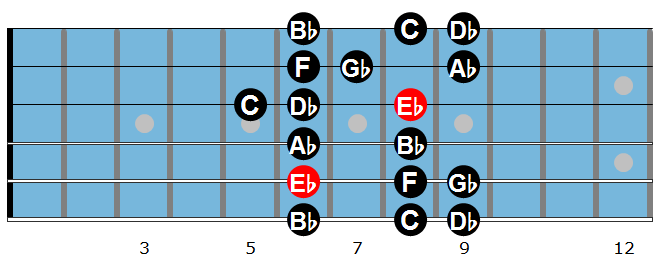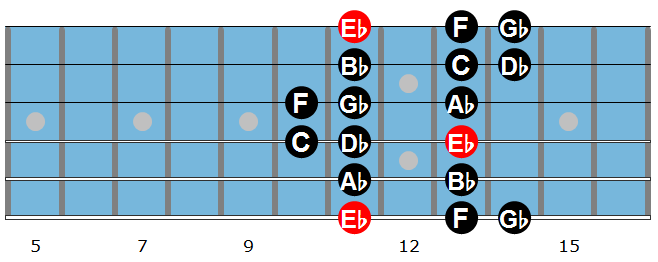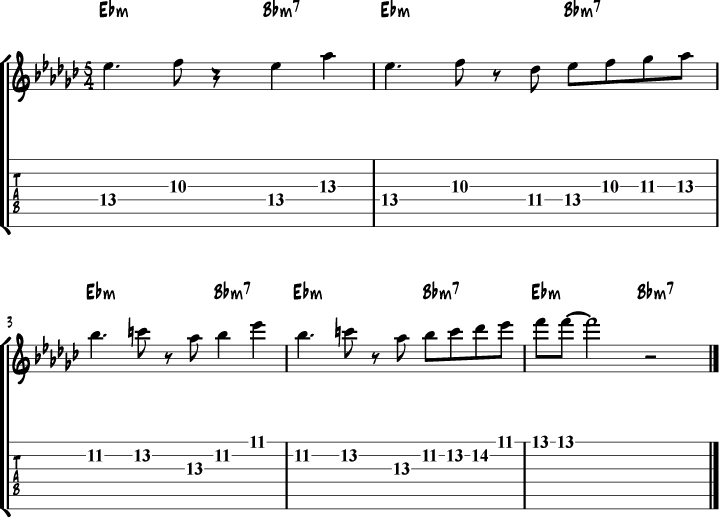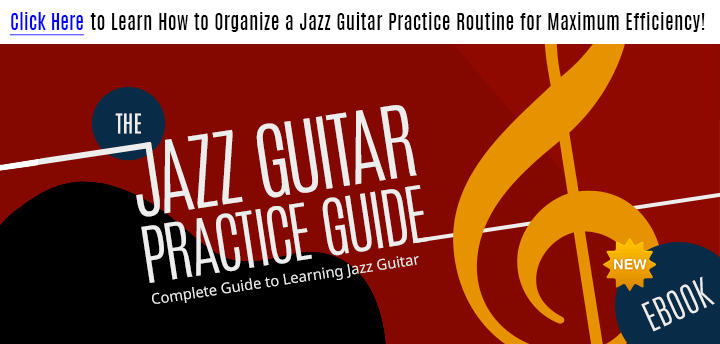Take Five is a classic jazz standard that many guitarists learn at one time or another in their development. But, while it can seem like a straight-forward progression that only uses two chords, creating a memorable solo over this tune is tougher than it seems.
To help you solo over Take Five, and learn more about the soloing techniques of one of jazz’s greatest improvisers, here are five classic Paul Desmond licks that you can add to your repertoire.
Not only will these lines help you navigate the Take Five chords, but you will also get into the mind of a jazz sax legend at the same time.
Each lick is broken down so you can understand the material behind the lick, allowing you to add these lines to your vocabulary and increase your understanding of jazz improvisation at the same time.
Take Five Scales
All licks in this lesson use the same guitar scale, Eb Dorian.
The Eb Dorian scale comes from the parent key of Db major, as Dorian is the second mode of Db.
This means that when you play Eb Dorian, you are playing all the notes of the Db major scale, but starting from Eb rather than Db.
Here’s how that looks on paper:
| Db Major Scale | Db | Eb | F | Gb | Ab | Bb | C |
|---|---|---|---|---|---|---|---|
| 1 | 2 | 3 | 4 | 5 | 6 | 7 | |
| Eb Dorian Scale | Eb | F | Gb | Ab | Bb | C | Db |
| 1 | 2 | b3 | 4 | 5 | 6 | b7 |
Here are two fingerings for Eb Dorian that you can learn on the guitar, one from the 6th string root and one from the 5th string root:


Take 5 Lick 1 [starts at 1:05 in the video]
The first lick features a few nice leaps, such as the Bb to Eb in the first bar, as well as Paul Desmond’s characteristic use of space in the line.
This use of space is a part of the “Cool Jazz” sound that Desmond was famous for, and it helped define his voice on the instrument.

Take 5 Lick 2 [starts at 1:12 in the video]
In this Paul Desmond lick, you’ll see a line played in both bars, with a different ending for that lick in each measure.
This is a common jazz phrasing technique found in the solos of many great players, most notably Wes Montgomery on the guitar.
Here, you play the same phrase in the first half of both bars but then resolve that phrase differently in each bar.
This allows you to use the same line in two measures and not sound repetitive, it’s about developing the idea rather than repeating it exactly.

Take 5 Lick 3 [starts at 1:26 in the video]
In this lick, you’ll notice the use of the Ab triad over Ebm in the second measure.
When playing over minor or m7 chords, such as Ebm in this tune, you can use the related V or V7 chord to create color in your lines.
This means that if you are in the key of Db major, the iim chord is Ebm and the V chord is Ab.
By playing the V chord over the iim chord, you highlight the 11, 13, and root notes of the underlying chord.
This is a cool way to spice up your lines without doing anything more complicated than playing a diatonic triad in your lines.

Take 5 Lick 4 [starts at 1:34 in the video]
This is a “slow burner” lick, one that starts of slow and then picks up the pace as you move through the five-bar phrase.
By approaching the line this way, Desmond used space in the beginning, with fewer notes, as he builds intensity and increases the note volume by the end of the line.
When soloing over longer phrases, such as this five-bar line, try working your solos in this fashion.
Starting slow and building momentum is not only an effective way to mix up your phrasing, but it will also create energy and forward motion in your lines at the same time.

Take 5 Lick 5 [starts at 1:41 in the video]
In this final lick, you see another example of Desmond starting each bar with the same material, while the second half of the bar end differently each time.
As you can see, in this phrase he does this over a four-bar span, much longer than the examples you saw previously.
In order to recreate a line like this in your playing, you’ll have to be able to keep the melodic idea at the start of the bar in your ears and memory.
To do this, practice repeating small musical motives in your solos, which will help you work on keeping those ideas in your playing, coming back to them time and again as you develop them throughout your solo.

Take Five Trivia
- Take Five was written by alto saxophonist Paul Desmond and performed by The Dave Brubeck Quartet on the album Time Out (1959).
- In 1961 it became the biggest-selling jazz single ever.
- Take Five was one of the first jazz compositions with a time signature other than 4/4 or 3/4.
- The single is a different recording than the LP version, most of the drum solo is omitted.
- The performance royalties of Take 5 (and all other Paul Desmond compositions) go to the American Red Cross.



There are also a few Eb minor pentatonic licks,e.g. the theme!
If Take 5 is in Eb Dorian (2nd mode of Db) then why is the key sig in all the Real Books six flats (Gb) instead of 5 flats (Db)? That would be Eb natural minor, not Dorian. I’m confused.
Because the key of Eb dorian doesn’t exist. With six flats you have only two solutions : Gb maj or Eb min. Take five is in Eb min. But there is a lot of minor scales (harmonic, melodic, phrygian, dorian, natural minor…) In this modal way (and take five is a modal cadence) you give the “colour” of the dorian scale with a pure sixth (not flat like in Eb minor natural). Eb dorian is not a relative of a major scale. It’s only the sames intervals of a Ab major scale from its second degree. It’s only a question of fingering. But they are totally different scales.
I mean “it’s only the same intervals of a Db scales from the second degree (not Ab)
Yeah I thought the same. But with anything jazz I suppose the idea is that while you are in the Eb- Bb- vamp The dorian will work. its still minor and it gives you a Major 6th interval on the Eb- chord and a Maj 9th on the Bb- chord. The Cb (B) of the natural minor kind of clashes with both of these chords if you land on it and its better as a passing note whereas the C sounds cool.
Fantastic, Thanks
Every time I run into a jazz group doing their thing, I request this song. Always sounds different and no solos are alike. That’s what makes this tune so unique. Thanks
Where’s that confounded bridge? This song has more than two chords. The bridge is fairly tricky (timing) and to me is the essence of the song. So is the melody that is not that easy to play in Ebm position but lots of fun to get down.
Thanks for the work, it is much appreciated.
Hey Pat, the solo in the original recording is on only the Ebm/Bbm7 part…
Is this key signature G flat? Thanks!
Hi Phil, Take Five is in Eb minor (the relative minor of Gb major).
This is really helpful. I am struggling with jazz guitar in general and this gives me a really solid basis to work on. Thanks very much.
Thanks Dirk. This is an old favourite of mine, and a very useful article from you. I think that Paul Desmond is somewhat underrated by many. For me, I know of no other alto sax player that produces such a sweet and mellow tone. Many great sax players, to my mind, err on the side of sounding a little too brash!
You have a great site. I get so involved with all other things in life, I forget about things. I plan to get going on my guitar once again, and offer more support! thanks Kevin c
Thank you. This is one of my favorite tunes.
Great lesson!
I’ve been playing this song for close to 30 years. It’s just one of those songs that never gets stale.
Thanks!